engine coolant Oldsmobile Aurora 1997 s User Guide
[x] Cancel search | Manufacturer: OLDSMOBILE, Model Year: 1997, Model line: Aurora, Model: Oldsmobile Aurora 1997Pages: 404, PDF Size: 20.75 MB
Page 235 of 404

How to Add Coolant to the Coolant
Surge Tank
If you haven’t found a problem yet, but the coolant level
isn’t at
FULL COLD, add a 50/50 mixture of clean
water
(preferably distilled) and DEX-COOL@ coolant at
the coolant surge tank, but be sure the cooling system,
including the coolant surge tank pressure cap, is cool
before you do it. (See “Engine Coolant’’ in the Index
for
more information.)
Steam and scalding liquids from
a hot cooling
system can blow out and burn you badly. They
are under pressure, and if you turn the coolant
surge tank pressure cap
-- even a little -- they
can come out at
high speed. Never turn the
cap when the cooling system, including the
coolant surge tank pressure cap, is hot. Wait
for the cooling system and coolant surge tank
pressure cap to cool if you ever have to turn the
pressure cap.
I
Page 236 of 404
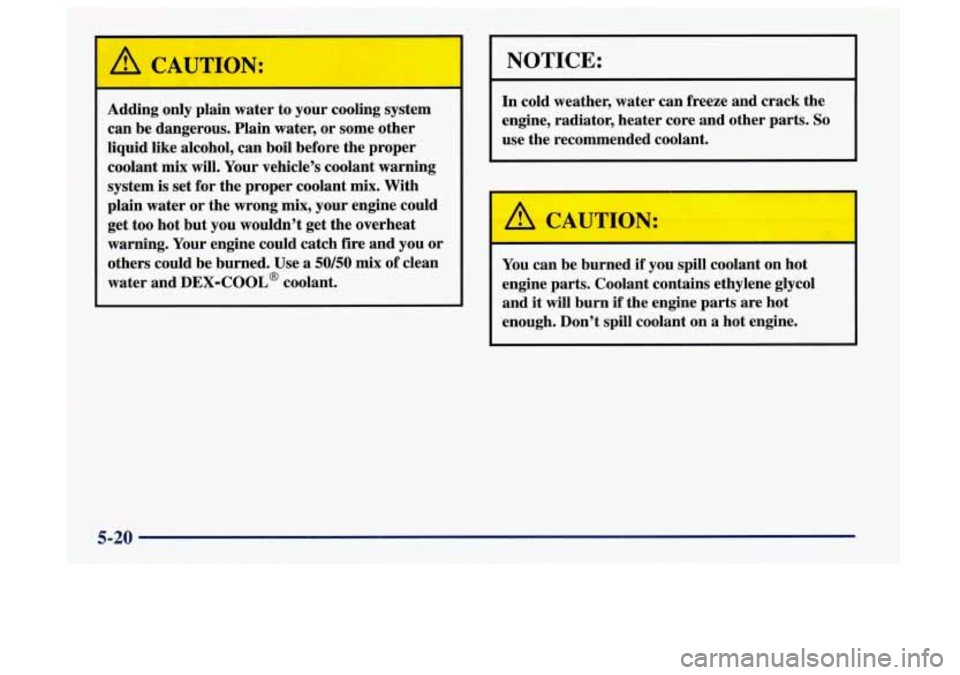
A CAUTION:
Adding only plain water to your cooling system
can be dangerous. Plain water, or some other
liquid like alcohol, can boil before the proper
coolant mix will. Your vehicle’s coolant warning
system is set for the proper coolant mix. With
plain water
or the wrong mix, your engine could
get
too hot but you wouldn’t get the overheat
warning. Your engine could catch fire and you or
others could be burned. Use a
50/50 mix of clean
water and DEX-COOL@ coolant.
NOTICE:
In cold weather, water can freeze and crack the
engine, radiator, heater core and other parts.
So
use the recommended coolant.
~~ ~ ~
You
can be burned if you spill coolant on hot
engine parts. Coolant contains ethylene glycol
and it will burn if the engine parts are hot
enough. Don’t spill coolant on
a hot engine.
5-20
Page 238 of 404
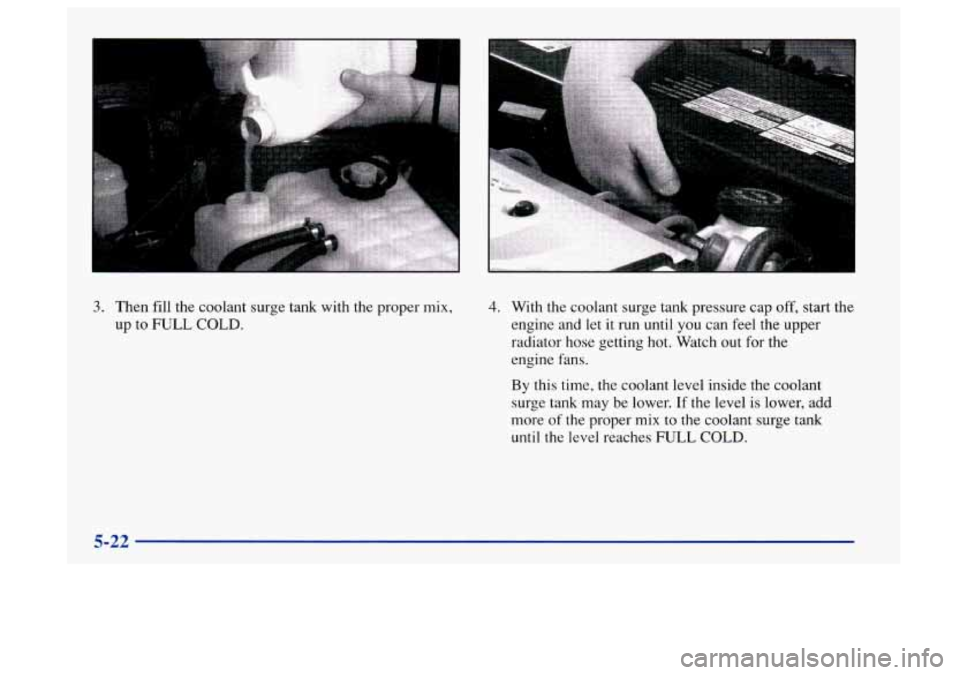
3. Then fill the coolant surge tank with the proper mix,
up to FULL COLD. 4. With the coolant surge tank pressure cap off, start the
engine and let
it run until you can feel the upper
radiator hose getting hot. Watch out for the
engine fans.
By this time, the coolant level inside the coolant
surge tank may be lower.
If the level is lower, add
more of the proper mix to the coolant surge tank
until the level reaches FULL COLD.
5-22
Page 253 of 404
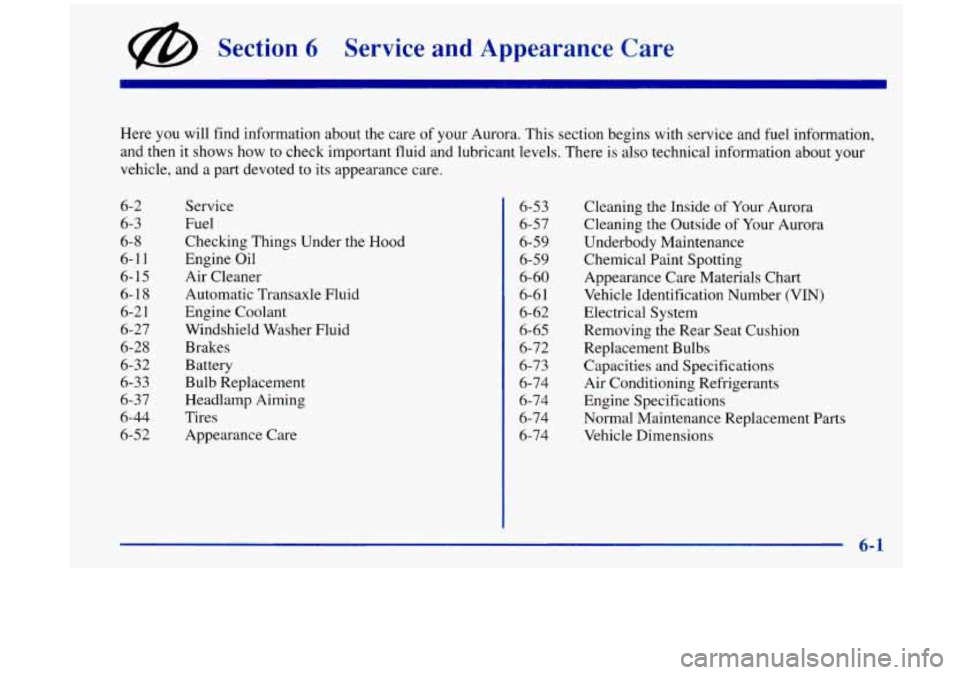
@ Section 6 Service and Appearance Care
Here you will find information about the care of your Aurora. This section begins with service and fuel information,
and then it shows how to check important fluid and lubricant levels. There is also technical information about your
vehicle, and a part devoted to its appearance care.
6-2
6-3
6-8
6-1 1
6-15 6-18
6-2
1
6-27
6-28
6-32
6-33
6-3 7
6-44
6-52 Service
Fuel
Checking Things Under the Hood
Engine Oil
Air Cleaner
Automatic Transaxle Fluid
Engine Coolant Windshield Washer Fluid
Brakes
Battery
Bulb Replacement
Headlamp Aiming
Tires
Appearance Care 6-53
6-57
6-59
6-59
6-60 6-6 1
6-62
6-65
6-72
6-73
6-74
6-74
6-74
6-74 Cleaning the
Inside
of Your Aurora
Cleaning the Outside
of Your Aurora
Underbody Maintenance Chemical Paint Spotting
Appearance Care Materials Chart
Vehicle Identification Number (VIN)
Electrical System
Removing the Rear Seat Cushion
Replacement Bulbs
Capacities and Specifications
Air Conditioning Refrigerants
Engine Specifications
Normal Maintenance Replacement Parts
Vehicle Dimensions
6-1
Page 260 of 404
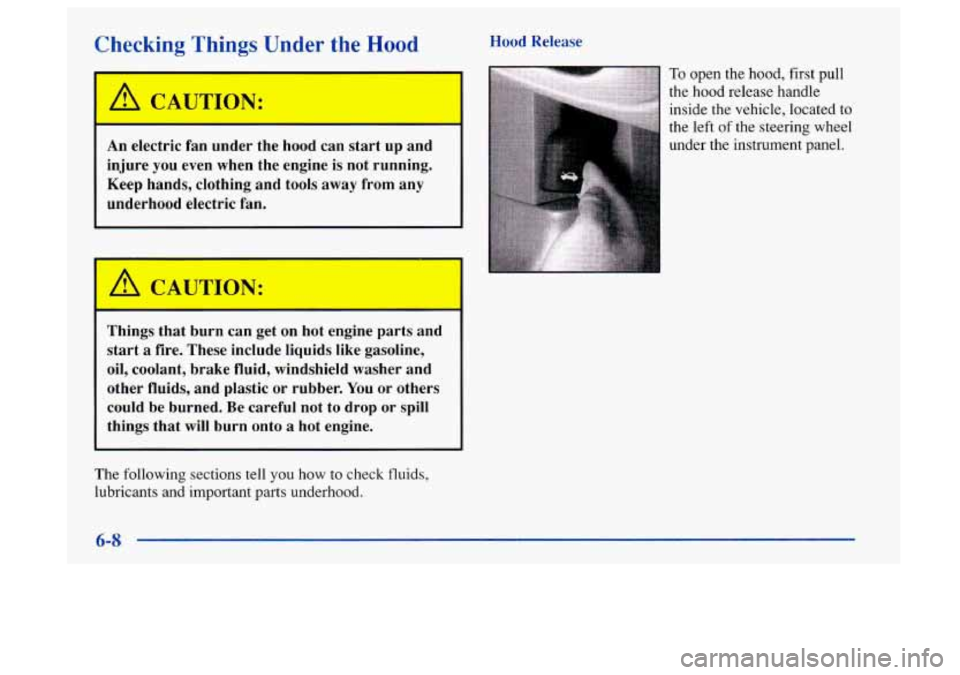
Checking Things Under the Hood
I k!, CAUTION:
An electric fan under the hood can start up and
injure you even when the engine is not running.
Keep hands, clothing and tools
away from any
underhood electric fan.
1
I
Things that burn can get on hot engine parts and start
a fire. These include liquids like gasoline,
oil, coolant, brake fluid, windshield washer and
other fluids, and plastic
or rubber. You or others
could be burned. Be careful not to drop or spill
things that will burn onto
a hot engine.
The following sections tell you how
to check fluids,
lubricants and important parts underhood. Hood Release
To open the hood,
first pull
the
hood release handle
inside the vehicle, located
to
the left of the steering wheel
under the instrument panel.
6-8
Page 262 of 404
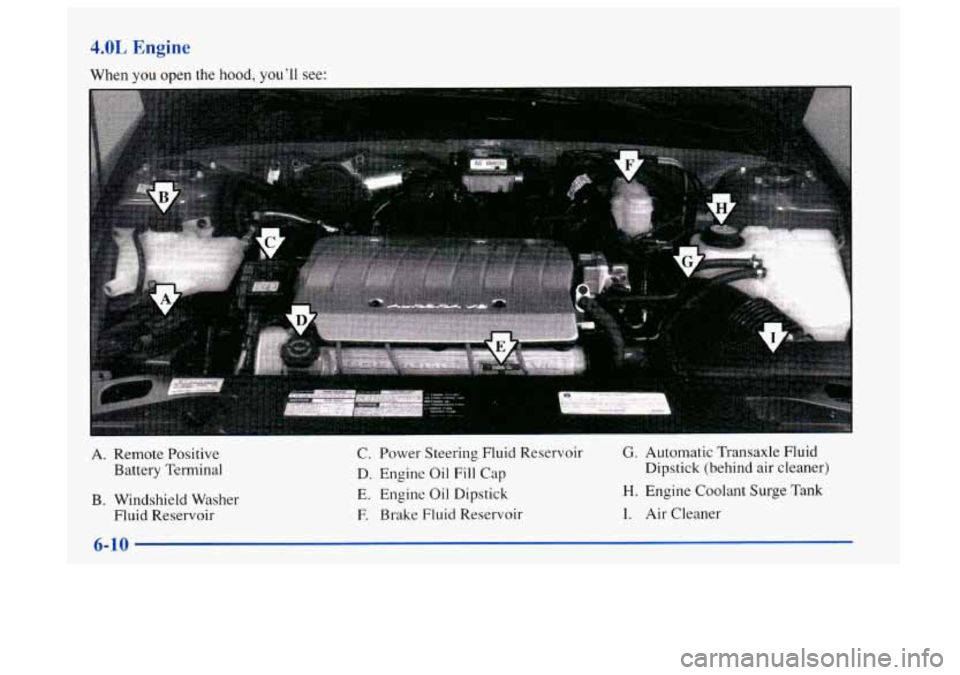
4.0L Engine
When you open the hood, you’ll see: ~
A. Remote Positive
Battery Terminal
B. Windshield Washer
Fluid Reservoir C. Power Steering
Fluid Reservoir
D. Engine Oil
Fill Cap
E. Engine Oil Dipstick
F. Brake Fluid Reservoir
G. Automatic Transaxle Fluid
Dipstick (behind air cleaner)
H. Engine Coolant Surge Tank
I. Air Cleaner
6-10
Page 273 of 404
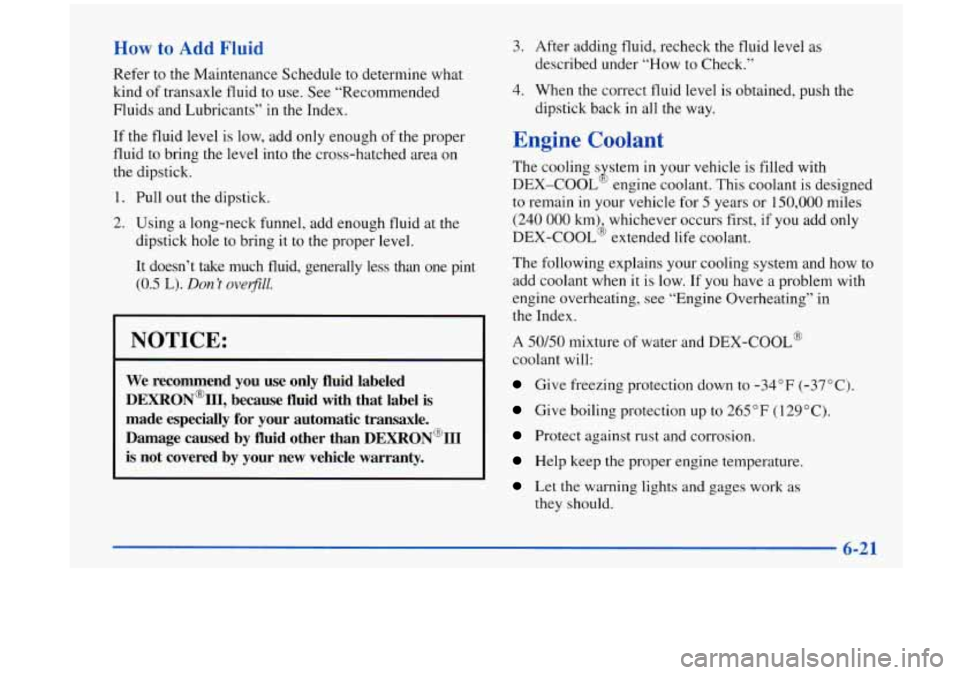
How to Add Fluid
Refer to the Maintenance Schedule to determine what
kind of transaxle fluid to use. See “Recommended
Fluids and Lubricants” in the Index.
If the fluid level
is low, add only enough of the proper
fluid
to bring the level into the cross-hatched area on
the dipstick.
1. Pull out the dipstick.
2. Using a long-neck funnel, add enough fluid at the
dipstick hole to bring it to
the proper level.
3. After adding fluid, recheck the fluid level as
described under “How to Check.”
4. When the correct fluid level is obtained, push the
dipstick back
in all the way.
Engine Coolant
The cooling s stem in your vehicle is filled with
DEX-COOL engine coolant. This coolant
is designed
to remain
in your vehicle for 5 years or 150,000 miles
(240 000 km), whichever occurs first, if you add only
DEX-COOL@ extended life coolant.
Lx
It doesn’t take much fluid, generally less than one pint The following explains
Your cooling system and how to
(0.5 L). Don’t overjill. add coolant when it is low. If you have a problem with
engine overheating, see “Engine Overheating” in
the Index.
NOTICE: A 50/50 mixture of water and DEX-COOL’
coolant will:
We recommend you use only fluid labeled
DEXRON’III, because fluid with that label is
made especially for your automatic transaxle.
Damage caused by fluid other than
DEXRON@III
is not covered by your new vehicle warranty.
Give freezing protection down to -34°F (-37°C).
Give boiling protection up to 265°F (129°C).
Protect against rust and corrosion.
Help keep the proper engine temperature,
Let the warning lights and gages work as
they should.
Page 274 of 404
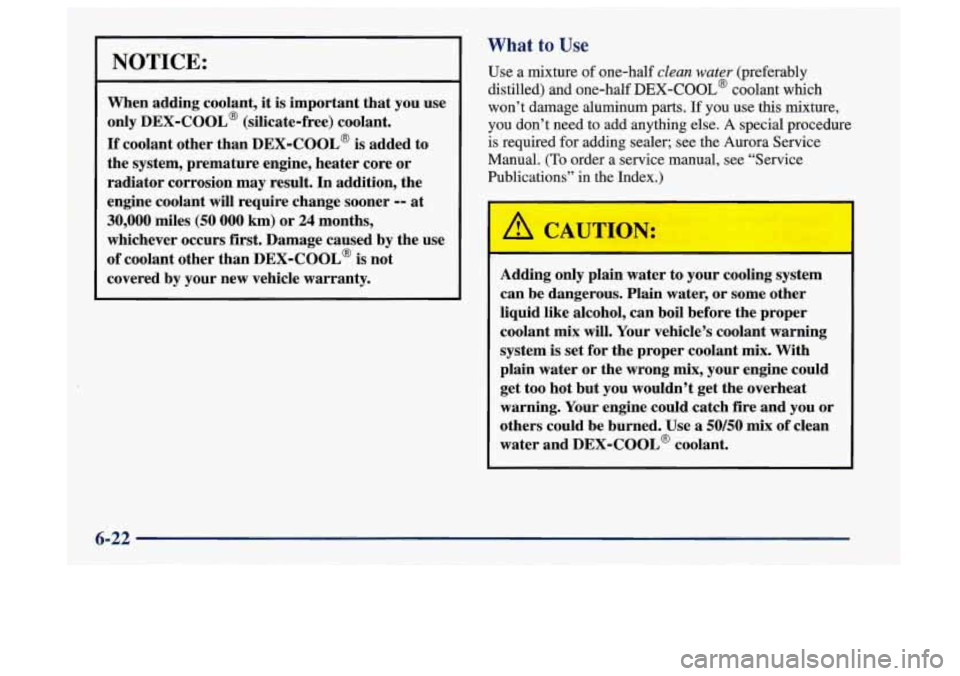
What to Use I
NOTICE:
When adding coolant, it is important that you use
only
DEX-COOL@ (silicate-free) coolant.
If coolant other than DEX-COOL@ is added to
the system, premature engine, heater core or
radiator corrosion may result.
In addition, the
engine coolant will require change sooner
-- at
30,000 miles (50 000 km) or 24 months,
whichever occurs
first. Damage caused by the use
of coolant other than DEX-COOL@ is not
covered by your new vehicle warranty.
Use a mixture of one-half clean water (preferably
distilled) and one-half
DEX-COOL@ coolant which
won’t damage aluminum
parts. If you use this mixture,
you don’t need to add anything else. A special procedure
is required for adding sealer; see the Aurora Service
Manual.
(To order a service manual, see “Service
Publications’’ in the Index.)
r =
Adding only plain water to your cooling system
can be dangerous. Plain water, or some other
liquid like alcohol, can boil before the proper
coolant
mix will. Your vehicle’s coolant warning
system
is set for the proper coolant mix. With
plain water or the wrong
mix, your engine could
get too hot but you wouldn’t get the overheat
warning. Your engine could catch fire and
you or
others could be burned. Use
a 50/50 mix of clean
water and DEX-COOL@ coolant.
6-22
Page 275 of 404
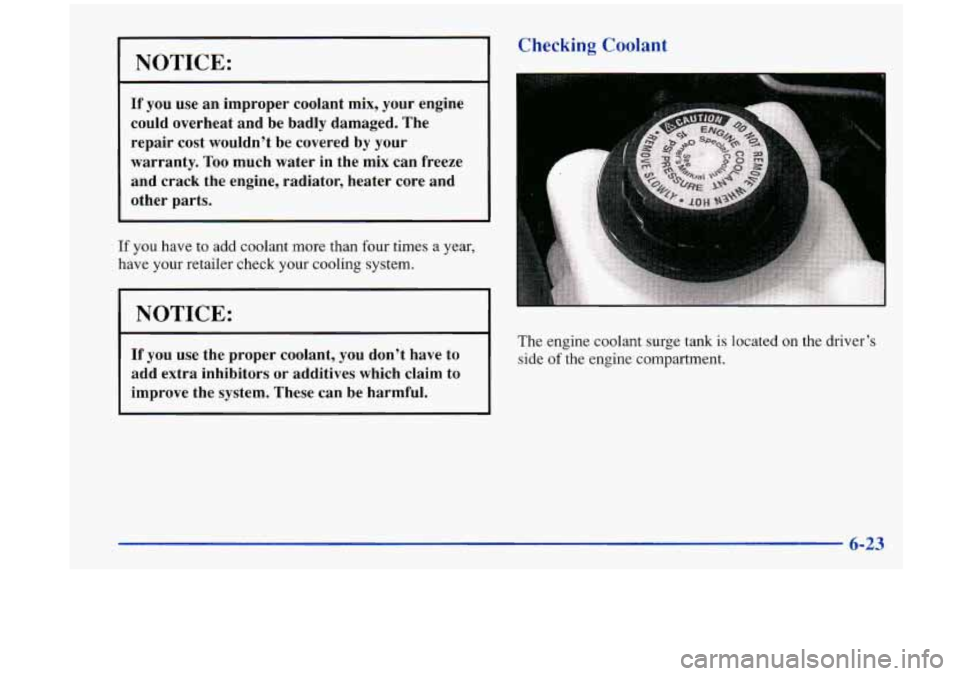
I
NOTICE:
If you use an improper coolant mix, your engine
could overheat and be badly damaged. The
repair cost wouldn’t be covered by your
warranty. Too much water in the mix can freeze
and crack the engine, radiator, heater core and
other parts.
If you have to add coolant more than four times a year,
have your retailer check your cooling system.
I NOTICE:
If you use the proper coolant, you don’t have to
add extra inhibitors or additives which claim to
improve the system. These can be harmful.
Checking Coolant
The engine coolant surge tank is located on the driver’s
side
of the engine compartment.
6-23
- ~.
Page 276 of 404
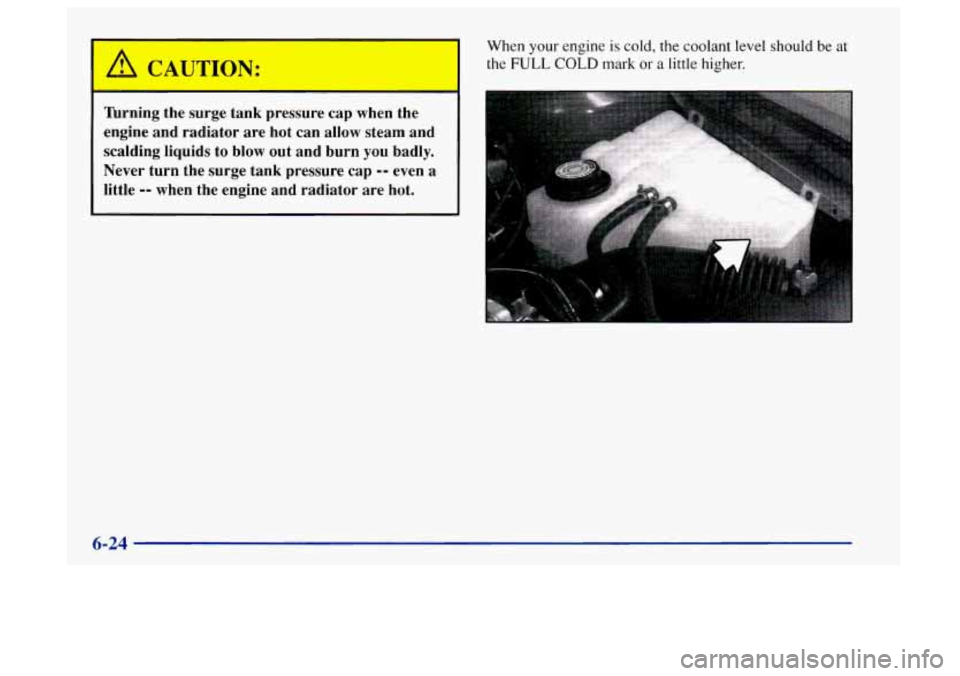
A CAUTION:
'hrning the surge tank pressure cap when the
engine and radiator are hot can allow steam and
scalding liquids to blow out and burn
you badly.
Never turn the surge tank pressure cap
-- even a
little
-- when the engine and radiator are hot.
When your engine is cold, the coolant level should be at
the
FULL COLD mark or a little higher.
6-24